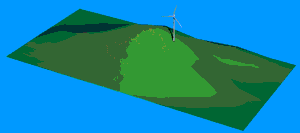Notebooks of
Leonardo da Vinci
(1452-1519)
Speed Up Effects: Hill Effect
![]()

A common way of siting wind turbines is to place them on hills or ridges
overlooking the surrounding landscape. In particular, it is always an advantage
to have as wide a view as possible in the prevailing wind direction in the
area.
![]() On hills, one may also experience that wind speeds are higher than in
the surrounding area. Once again, this is due to the fact that the wind
becomes compressed on the windy side of the hill, and once the air reaches
the ridge it can expand again as its soars down into the low pressure area
on the lee side of the hill.
On hills, one may also experience that wind speeds are higher than in
the surrounding area. Once again, this is due to the fact that the wind
becomes compressed on the windy side of the hill, and once the air reaches
the ridge it can expand again as its soars down into the low pressure area
on the lee side of the hill.

You may notice that the wind in the picture starts bending some time
before it reaches the hill, because the high pressure area actually extends
quite some distance out in front of the hill.
![]() Also, you may notice that the wind becomes very irregular, once it passes
through the wind turbine rotor.
Also, you may notice that the wind becomes very irregular, once it passes
through the wind turbine rotor.
![]() As before, if the hill is steep or has an uneven surface, one may get
significant amounts of turbulence, which may negate
the advantage of higher wind speeds.
As before, if the hill is steep or has an uneven surface, one may get
significant amounts of turbulence, which may negate
the advantage of higher wind speeds.
![]()
|
Back | Home | Forward |
© Copyright 1998 Soren Krohn. All rights reserved.
Updated 6 August 2000
http://www.windpower.org/tour/hill.htm